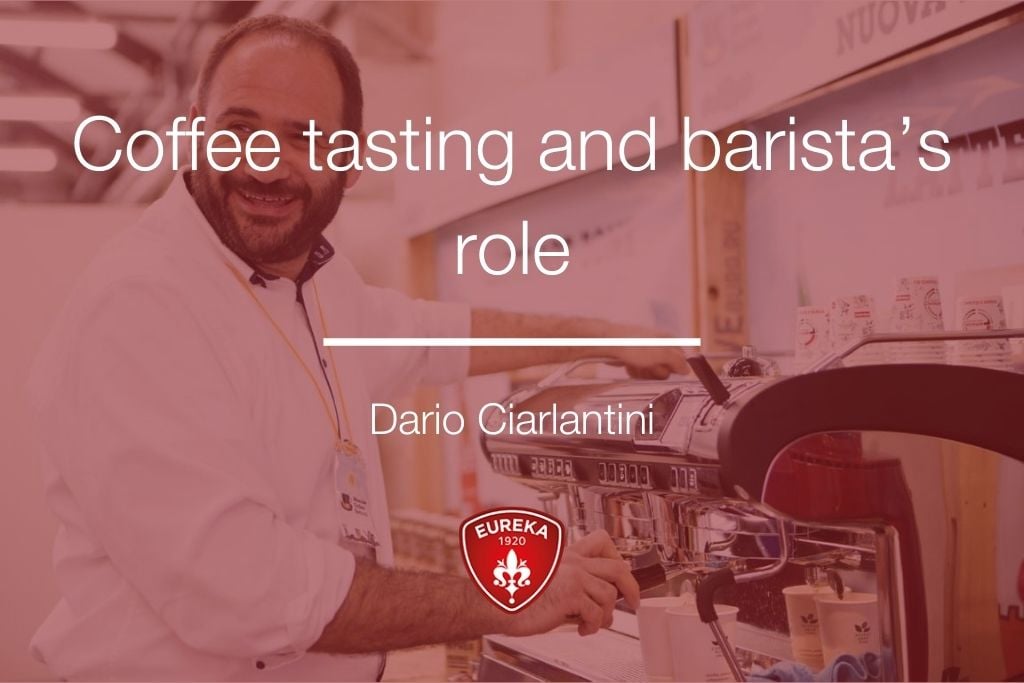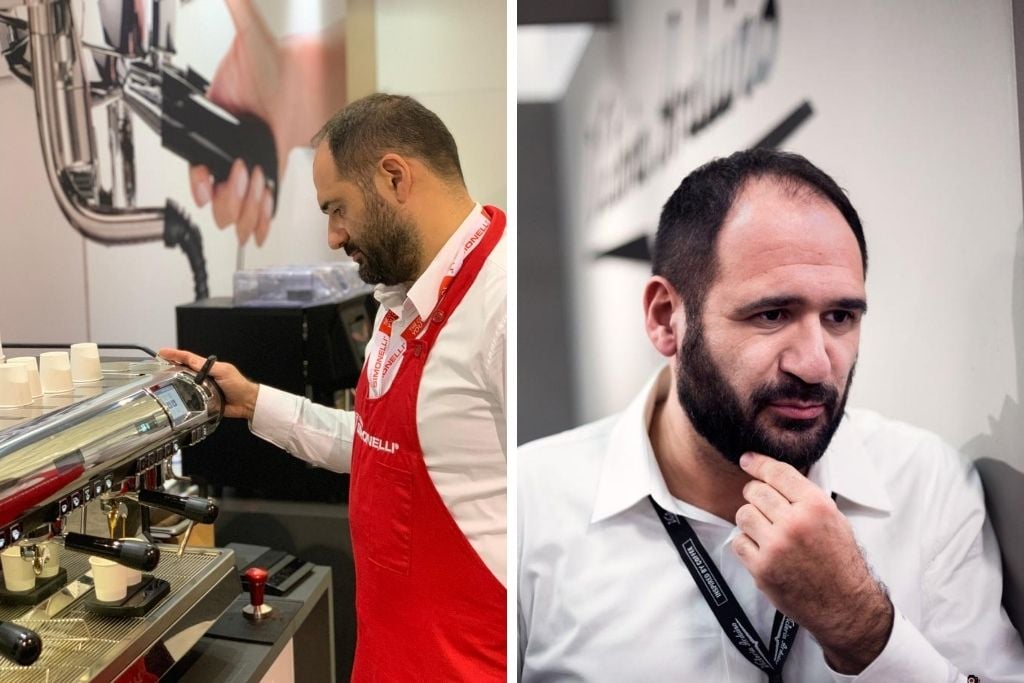Eureka Blog
Coffee tasting and barista’s role: Dario Ciarlantini’s view, alias Mr. Purge

Behind a good coffee, we can experience a wide range of aromas; each coffee offers different sensory notes, depending on the quality of raw material, the degree of roasting and the barista’s skills. Clearly, not everyone has enough time to fully perform a sensory analysis each time we have a coffee in a bar. However, coffee can be tasted according to well-defined rules, as there are for wine, beer and olive oil. Skills, curiosity and experience are crucial in coffee tasting. We will talk about this, and much more, with Dario Ciarlantini, trainer and advisor for many important companies in the coffee industry.
Dario, you are more popular as Mr. Purge. How did you get this nickname?
A Rai television program, Report, made an investigation into coffee; I got the “nickname” after it. Indeed Bernardo Iovene, the reporter, is examinating the correct coffee making: “First of all, we need to purge. If not, you will see that the water is dirty and you will have a bad coffee”. In fact, I’m the one explaining what purge is on the show. Since then, the term « purge » has been shared by general public. Actually, I enjoy this nickname and I’ll keep it.
Let’s have a talk on these technical matters. In which way grinding can affect a perfect coffee?
Grinding and coffee-equipment cleaning are the most important steps for a perfect coffee. It’s a matter of fact : if you grind incorrectly, you will have a bad coffee, as grinding can affect in over-extracting or under-exctracting a coffee; so it can either bring out or spoil any flavour. It’s easy to get wrong. The type of coffee is subjective ; that means its quality can be appreciated or not depending on personal taste. Instead, grinding is an objective matter.
Training is crucial
Coffee tasting can be learned with personal experiences and dedication. Nevertheless, your curiosity and desire to find out new flavours and emotions are crucial in order to fully appreciate organoleptic features.
How to learn to taste a coffee?
To know, to taste and to appreciate coffee flavours are part of a range of experiences that you approach step by step. Tasting helps you out in understanding some features of different coffee types. Everyone knows the grandmother’s or mother’s moka. Coffee means emancipation, already when you are a kid. At the beginning, a good coffee is much enjoyed with a little sugar in it; after, you get curious about. If you enjoy the coffee without adding sugar, it will be a completly different one. Taking off sugar is the first step in real tasting and, then, you are dedicated to find out any flavour; like bitter or natural sweet taste.
So, is that a matter of training your taste?
Definitely. You have to constantly train it. This is the key to become a coffee sommelier, as you will have new connections based on aromas and flavours. You will detect any nuances or have a personal memory and flavour.

So, tasting is an intimate and subjective moment and training is crucial. But there are tasting sheets that help you out to make sensory classification more objective. Are these sheets useful?
We could have a long talk on this. As we can’t, I’ll say yes: these are useful depending on the way they are used. We can say these are objective in terms of both quantitative and qualitative analysis.
The first means the intensity of considered features, as acidity, bitterness and so on. Here, training is essential, even if it’s easier, more intuitive and approachable compared to any quality-based analysis. The second, on the other hand, requires an evaluation on the quality of organoleptic aspects. You have to be well-trained to assess objectively, both in knowledge and experience. If not, it’s detrimental. The correct assesment of different features is as difficult as it is essential. The most important point of these sheets ? All is written down and can be used for future comparisons. Moreover, the sheets can be useful even after months or years, so to understand the evolution of the same coffee or choose different ones with features more suitable to our needs.
There are different type of tasting sheets. To you, how a perfect sheet should be ?
Simple and fast to fill in; clear to get to assess right after having tasted a coffee. I’m a fan of any sheet having few essential criteria and enough space to write down some notes. This way you can evaluate the intensity of features with a simple tick; and this is intuitive and easy. You can also write down some words better explaining your mark-based assessment. The result is an instant eye-impact of coffee aspects that will be useful to have a focus on qaulity-related notes. I think this is a method that can be easily used for a survey among consumers ; via the other way (marks on quality), it would be way harder.
Which are the coffe aromas or the flavours that impressd you mostly?
I was impressed in having a coffee that tastes of raspberry. It was so strong and nice. This raspberry flavour was perceived in both filter and espresso. It had a nice acidity and I enjoyed it even adding some sugar. This way you could feel also some raspberry jam and syrup flavours. That was an Ethiopia. It was interesting, being a strange natural combination. Beyond the flavour (you can like or dislike), it was a perfect example of sweetness, acidity, complexity and intensity: all in a coffee. I tought that was incredible. A seed of a fresh fruit can express unexpected aromas, even when roasted and undergone mechanical and thermical treatments.
Today’s baristas
No quality-related compromise and big communication skills: baristas have the duty (and the “power”) to pass down their passion and knowledge, by encouraging so any customer who tastes new coffees, combining training and information.
Which approach should a good barista have? How can a barista arise customer’s awarness?
A good barista should know coffees, even technically. He/she should pass down his/her passion , explaining any aspect that may get the customer curious about. This doesn’t mean just listing the technical matters of a coffee; it’s a matter of creating an experience. A barista should do all this avoiding the classic « show », putting him/herself in the customer’s shoes and speaking with easy words.
Do you have any mainstream advices for baristas?
Generally, I always say that we don’t have to compromise on quality. There are limits on quality that we have to respect. Then, I suggest to observe the characteristics of an espresso coffee that customers are expecting. Better said : if my customers are expecting a rich coffee, I have to stick to this. As a barista, if I had to choose a coffee equipment, I would pick it thermally stable regardless of the price. It will grant good extractions, as the barista should work on quality. We shuold not save some money on the coffe machine or coffee grinder. More, it is essential to clean the hopper and the doser. For example, burrs cleaning is often underestimated; actually, it’s extremely important. It will be necessary to spend a couple of hours in cleaning all, but these efforts will be rewarded.
Do you have any suggestion for home-users and coffee lovers?
Sure: purchase your home grinder and grind your coffee; even using your moka. Then, in a second step, if you want to upgrade your consumer experience, you could buy also an espresso coffee machine. In any case, regardless of the extraction system, the grinding is crucial. Both at home and at bars.
How can we go trough new experiences, involving people and avoiding that “show” you previously mentioned?
Exploring is always important. When you want to propose something original, the right way consists in arranging events and tastings. It’s also a matter of letting the people feel your passion.
There is a big risk behind: a special coffee proposed in a wrong way may let the people re-consider the usual coffee at the bar as a bad or untrue one. So we have to propose experiences and make customers aware they are taking part into a special moment.

The « perfect Coffee » according to Dario Ciarlantini
Little personal talks at the end of our interview, so to put Dario in the customer’s shoes and sharing his feelings.
What are your favourite coffee-shops? Where did you taste the perfect coffee?
Lately I had some feelings in choosing raw material and in extracting coffee at “Jesi caffè” bar, located in Jesi, Marche region. Other times I was impressed by “Faro” in Rome or “Tazze Pazze” by Andrea Cremone in Genoa (and I visit them both when nearby).
Which are the best coffees around the world?
I believe that Middle-East is the new coffee market. Here we can set great coffee-shops, investing in a huge range of raw materials as well as in different exctration methods, taking great care of quality. I think that Dubai and Saudi Arabia are innovative on this.
What is the perfect coffee according to Dario Ciarlantini?
A mix of sweet arabica, chocolaty, without robusta and with cocoa flavours, chocolate and red fruits.
